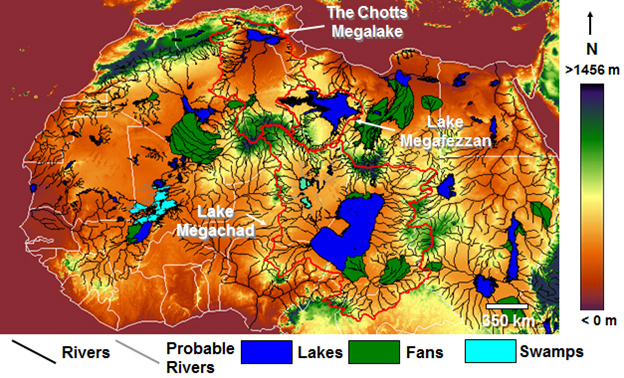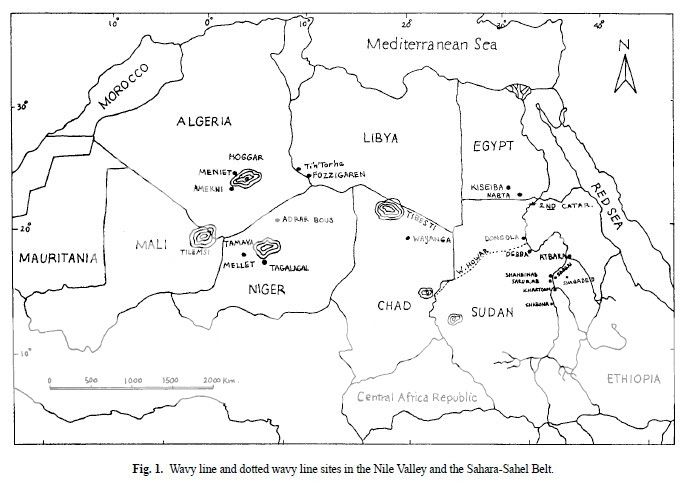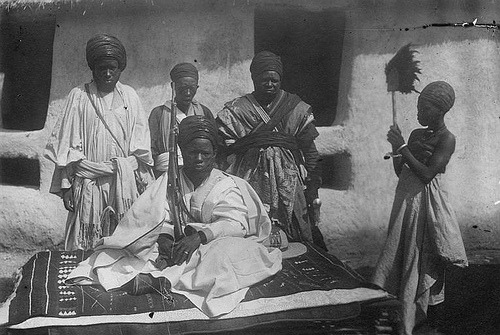RandomAfricanAm:
An account of the Dispersal of people across the sahale during the fall of kanem

People Have been in the sahale-Saharan area since around the aqualithic /green Saharan period.


The occupation of the Sahara was one that shared certain material culture commonalities throughout such as barbed harpoons for fishing and wavy lined pottery for storage.
[img]http://openi.nlm.nih.gov/imgs/rescaled512/2515196_pone.0002995.g007.png[/img]
[img]http://mathildasanthropologyblog.files./2008/08/ten-pot.jpg[/img]

As the Sahara began to dry out the people began to be pushed out of and mashed between, the desert and forest belt in what is now called the Sahale. Even though most of the occupants were dispersed from the Sahara specific trade routes would be maintained across it till relatively modern times.
Ancient

Modern

Between those two times came first the Garamantes of the Saharan Fezzen (southern Libya/northern Chad) and the Sao people of the Saharan lake chad(Northern Cameron/Southern Chad). Secondly Kanem rose in the Sahale along the trade rout
[img]http://upload.wikimedia.org/wikipedia/commons/b/b7/Niger_saharan_medieval_trade_routes.PNG[/img]
The Garamantes
(probably from Berber language: igherman; meaning: cities[citation needed] or igarraman; meaning: saints, holy/sacred people) were a Saharan people who used an elaborate underground irrigation system, and founded a prosperous Berber kingdom in the Fezzan area of modern-day Libya, in the Sahara desert. They were a local power in the Sahara between 500 BC and 700 AD.
There is little textual information about the Garamantes. Even the name Garamantes was a Greek name which the Romans later adopted. Available information comes mainly from Greek and Roman sources, as well as archaeological excavations in the area, though large areas in ruins remain unexcavated. Another important source of information is the abundant rock art, which often depicts life prior to the rise of the realm.
The Garamantes were probably present as tribal people in the Fezzan by 1000 BC. They appear in the written record for the first time in the 5th century BC: according to Herodotus, they were "a very great nation" who herded cattle, farmed dates, and hunted the "Ethiopian Troglodytes", or "cave-dwellers" who lived in the desert, from four-horse chariots.[4] Roman depictions describe them as bearing ritual scars and tattoos. Tacitus wrote that they assisted the rebel Tacfarinas and raided Roman coastal settlements. According to Pliny the Elder, Romans eventually grew tired of Garamantian raiding and Lucius Cornelius Balbus captured 15 of their settlements in 19 BC. In 202, Septimius Severus captured the capital city of Garama.[5]
Near East in 600 AD, showing the location of Garamantes before the Arab conquest.
By around 150 AD the Garamantian kingdom (in today's central Libya (Fezzan), principally along the still existing Wadi al-Ajal), covered 180,000 square kilometres in modern-day southern Libya. It lasted from about 400 BC to 600 AD.
The decline of the Garamantian culture may have been connected to worsening climatic conditions, or overuse of water resources.[6] What is desert today was once fairly good agricultural land and was enhanced through the Garmantian irrigation system 1,500 years ago. As fossil water is a non-renewable resource, over the six centuries of the Garamantian kingdom, the ground water level fell.[citation needed] The kingdom declined and fragmented.
The Sao
The Sao were an African civilization that flourished from ca. the sixth century BCE to as late as the sixteenth century CE. The Sao lived by the Chari River south of Lake Chad in territory that later became part of Cameroon and Chad. They are the earliest people to have left clear traces of their presence in the territory of modern Cameroon.[1] Sometime around the 16th century, conversion to Islam changed the cultural identity of the former Sao. Today, several ethnic groups of northern Cameroon and southern Chad but particularly the Kotoko claim descent from the civilization of the Sao.
Rise and decline
The Sao civilization may have begun as early as the sixth century BCE,[6] and by the end of the first millennium BCE, their presence was well established south of Lake Chad and near the Chari River.[7] The city states of the Sao reached their apex sometime between the ninth and fifteenth centuries CE.[7]
The Sao's demise may have come about due to conquest, Islamization, or both.[8] Traditional tales say that the Sao west of Lake Chad fell to "Yemenites" from the east. These invaders made several unsuccessful attempts to conquer the Sao before finally succeeding by resorting to trickery. If true, the newcomers may have been Arab Bedouin or Sayfuwa raiders coming from the east who moved into the region in the fourteenth century .[9] Although some scholars estimate that the Sao civilization south of Lake Chad lasted until the fourteenth or fifteenth century, the majority opinion is that it ceased to exist as a separate culture sometime in the 16th century subsequently to the expansion of the Bornu Empire.[10] The Kotoko are the inheritors of the former city states of the Sao.[11]
Culture
Little is known about the Sao's culture or political organisation: They left no written records and are known only through archaeological finds and the oral history of their successors in their territory.[5] Sao artifacts show that they were skilled workers in bronze, copper, and iron.[8] Finds include bronze sculptures and terra cotta statues of human and animal figures, coins, funerary urns, household utensils, jewellery, highly decorated pottery, and spears.[12] The largest Sao archaeological finds have been made south of Lake Chad.
Ethnic groups in the Lake Chad basin, such as the Buduma, Gamergu, Kanembu, Kotoko, and Musgum claim descent from the Sao. Lebeuf supports this connection and has traced symbolism from Sao art in works by the Guti and Tukuri subgroups of the Logone-Birni people.[13] Oral histories add further details about the people: The Sao were made up of several patrilineal clans who were united into a single polity with one language, race, and religion. In these narratives, the Sao are presented as giants and mighty warriors who fought and conquered their neighbors.


The Kanem Empire
The Kanem Empire(ca. 700 - 1376) was located in the present countries of Chad, Nigeria and Libya.[2] At its height it encompassed an area covering not only much of Chad, but also parts of southern Libya (Fezzan) and eastern Niger, northeastern Nigeria and northern Cameroon. The history of the Empire is mainly known from the Royal Chronicle or Girgam discovered in 1851 by the German traveller Heinrich Barth
Origins
The empire of Kanem began forming around AD 300 under the nomadic Tebu-speaking Kanembu. Also, the first african empire. According to the Girgam, the Kanembu were forced southwest towards the fertile lands around Lake Chad by political pressure and desiccation in their former range. The area already possessed independent, walled city-states belonging to the Sao culture. Under the leadership of the Duguwa dynasty, the Kanembu would eventually dominate the Sao, but not before adopting many of their customs. War between the two continued up to the late 16th century.
One theory proposes that the lost state of Agisymba (mentioned by Ptolemy in the middle of the 2nd century AD) was the antecedent of the Kanem Empire.
Duguwa Dynasty (Kanembu)
Kanem was located at the southern end of the trans-Saharan trade route between Tripoli and the region of Lake Chad. The Kanembu eventually abandoned their nomadic lifestyle and founded a capital around 700 AD under the first documented Kanembu king ("mai" known as Sef of Saif. The capital of N'jimi (the word for "south" in the Teda language) grew in power and influence under Sef's son, Dugu. This transition marked the beginning of the Duguwa Dynasty. The mais of the Duguwa were regarded as divine kings and belonged to the ruling establishment known as the Magumi. Despite changes in dynastic power, the magumi and the title of mai would persevere for over a thousand years. known as Sef of Saif. The capital of N'jimi (the word for "south" in the Teda language) grew in power and influence under Sef's son, Dugu. This transition marked the beginning of the Duguwa Dynasty. The mais of the Duguwa were regarded as divine kings and belonged to the ruling establishment known as the Magumi. Despite changes in dynastic power, the magumi and the title of mai would persevere for over a thousand years.
Sayfawa Dynasty
The major factor that influenced the history of the state of Kanem was the early penetration of Islam. North African traders, Berbers and Arabs, brought the new religion. In 1085, a Muslim noble by the name of Hummay removed the last Duguwa king Selma from power and thus established the new dynasty of the Sefuwa.
The introduction of the Sefuwa dynasty meant radical changes for the Kanem Empire. First, it meant the Islamization of the court and state policies. Second, the identification of founders had to be revised. After the 13th century, the empire began associating Mai Sef with the legendary Yemenite hero Sayf ibn Dhi Yazan. Hence, it became customary to call the new ruling dynasty the Sayfawa instead of the Sefuwa.
Islam and Kanem
Islam offered the Sayfawa rulers the advantage of new ideas from Arabia and the Mediterranean world, as well as literacy in administration. But many people resisted the new religion, favouring traditional beliefs and practices. When Hummay had assumed power on the basis of his strong Islamic following, for example, it is believed that the Duguwa/Sefuwa began some kind of internal opposition. This pattern of conflict and compromise with Islam occurs repeatedly in Chad's history.
By the 12th century, the Sayfawa ruled all over Kanem. At the same time, the Kanembu people drew closer to the new rulers and increased the growing population in Njimi. Even though the Kanembu became the main power base of the Sayfawa, Kanem's rulers continued to travel frequently throughout the kingdom and especially towards Bornu, west of lake Chad. Herders and farmers alike recognized the government's power and acknowledged their allegiance by paying tribute.
Mai Dunama Dabbalemi
Kanem's expansion peaked during the long and energetic reign of Mai Dunama Dabbalemi (ca. 1221–1259), also of the Sayfawa dynasty. Dabbalemi initiated diplomatic exchanges with sultans in North Africa and apparently arranged for the establishment of a special hostel in Cairo to facilitate pilgrimages to Mecca. During his reign, he declared jihad against the surrounding tribes and initiated an extended period of conquest. After consolidating their territory around Lake Chad, the Fezzan region (in present-day Libya) fell under Kanem's authority, and the empire's influence extended westward to Kano (in present-day Nigeria), eastward to Ouaddaï, and southward to the Adamawa grasslands (in present-day Cameroon). However, he also destroyed the national Mune cult and thus precipitated widespread revolt culminating in the uprise of the Tubu and the Bulala. The former could be quenched but the latter continued to linger on and finally led to the retreat of the Sayfuwa from Kanem to Bornu c. 1380.
Dabbalemi devised a system to reward military commanders with authority over the people they conquered. This system, however, tempted military officers to pass their positions to their sons, thus transforming the office from one based on achievement and loyalty to the mai into one based on hereditary nobility. Dabbalemi was able to suppress this tendency, but after his death, dissension among his sons weakened the Sayfawa Dynasty. Dynastic feuds degenerated into civil war, and Kanem's outlying peoples soon ceased paying tribute.
Fall of Kanem
After the death of Dunama II, Kanem quickly fell into a downward spiral. By the end of the 14th century, internal struggles and external attacks had torn Kanem apart.
Sao Resurgence
Between 1342 and 1352, the Sao, who had dominated Kanem prior to the Zaghawa, killed four mais in battle. The proliferation of mai claimants to the throne led to a series of internecine wars.
Bulala Invasion
The death knell of Sayfawa power in Kanem was dealt by the Bulala, invaders from the area around Lake Fitri to the east. By 1376, the Bulala had driven the Sayfawa from their capital. By 1388, they had taken Kanem altogether. The Kanuri were forced back into their nomadic ways and migrated west of Lake Chad, eventually establishing a new empire in Bornu.
[img]http://africanlegends.files./2011/12/kanem_bornu-court-ca-1700.jpg[/img]
.
.
.
.
Continued below These are some interesting threads. Ok, someone asked a question about the Toubou and I hope to clarify. First, Ghaddafi's bid against our people was a political one. And I hope that we're all aware of geo-politics. Africans tend to draw lines of division based on color, language and culture. This situation is no different. History attest the fact that we have inhabited the Libyan border since time immemorial and will continue to. Our land spans into the Tenere desert in Niger and down into Bornu. Yes, I said it,"into Bornu." Some Toubou clans have roots in Bornu and some Kanuri have roots in the BET of Chad and the Fezzan of Libya. In fact, they can still be found there today. Our oral traditions states we came from Arabia but this is most likely a transition of origin myth just as the Kanuri Girgam changes from a particular origin to an "Arab" one. The Toubou are of Garamante origin…hence the word "Gourane." We share much of the same blood with the Touareg except while the Touareg mixed with the Hausa and the Fulani, we mixed with the Wadai, Kanembu, Zaghawa and the Kanuri, especially the Kanuri. Also, the Fulani originated on the border of Algeria and Mali, not the Sahara. They are Kel Ouli, "people of the goat." Toubou are Ikaradan, cousins of Touareg but not dominated by the Touareg. |








 known as Sef of Saif. The capital of N'jimi (the word for "south" in the Teda language) grew in power and influence under Sef's son, Dugu. This transition marked the beginning of the Duguwa Dynasty. The mais of the Duguwa were regarded as divine kings and belonged to the ruling establishment known as the Magumi. Despite changes in dynastic power, the magumi and the title of mai would persevere for over a thousand years.
known as Sef of Saif. The capital of N'jimi (the word for "south" in the Teda language) grew in power and influence under Sef's son, Dugu. This transition marked the beginning of the Duguwa Dynasty. The mais of the Duguwa were regarded as divine kings and belonged to the ruling establishment known as the Magumi. Despite changes in dynastic power, the magumi and the title of mai would persevere for over a thousand years.